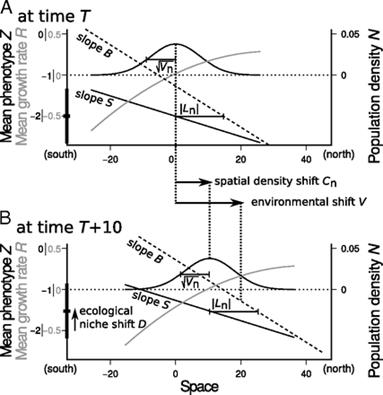花粉传播影响植物适应更热天气
来源:PNAS
作者:Robin Aguilée
时间:2016-10-09


近日,法国科研人员在美国《国家科学院院刊》上报告了一个能揭示植物对气候变化响应的新模型,其中纳入了花粉散布效应。该模型有助于更准确预测气候变暖可能带来的物种灭绝。
物种可能通过改变它们的地理范围,以跟随适宜的生活条件,或者适应不同气候,从而在全球气候变暖中生存下来。而理解植物适应气候变化的机制,对于确定哪些物种将有能力在其中幸存下来有关键作用。一些定量遗传学模型表明,一些逃离灭绝厄运的物种,可能改变了其地理范围,但同时保留了相同的生态位。
但针对植物进化的几个模型并没有预测宜居温度范围的变化,也忽视了花粉散布的效应,而花粉散布影响着基因流。对此,法国图卢兹第三大学的Robin Aguilée及其同事把花粉散播引入到了现有模型中,以分析它对植物气候变化响应的效应。
根据模型,增加花粉散播距离会减缓地理范围变化的速度。花粉散播也影响了群体适应新温度条件的速率。研究人员表示,如果忽略了花粉散播,特别是对于那些花粉散播得比种子更远的物种,预测气候变化导致的植物灭绝风险或未来地理范围改变可能不够准确。花粉散播可能让植物在比没有花粉散播的情况下,以更快的速率在气候变化中生存下来。(来源:科学网 张章)
Pollen dispersal slows geographical range shift and accelerates ecological niche shift under climate change
Abstract Species may survive climate change by migrating to track favorable climates and/or adapting to different climates. Several quantitative genetics models predict that species escaping extinction will change their geographical distribution while keeping the same ecological niche. We introduce pollen dispersal in these models, which affects gene flow but not directly colonization. We show that plant populations may escape extinction because of both spatial range and ecological niche shifts. Exact analytical formulas predict that increasing pollen dispersal distance slows the expected spatial range shift and accelerates the ecological niche shift. There is an optimal distance of pollen dispersal, which maximizes the sustainable rate of climate change. These conclusions hold in simulations relaxing several strong assumptions of our analytical model. Our results imply that, for plants with long distance of pollen dispersal, models assuming niche conservatism may not accurately predict their future distribution under climate change.
原文链接:http://www.pnas.org/content/early/2016/09/06/1607612113.full.pdf




